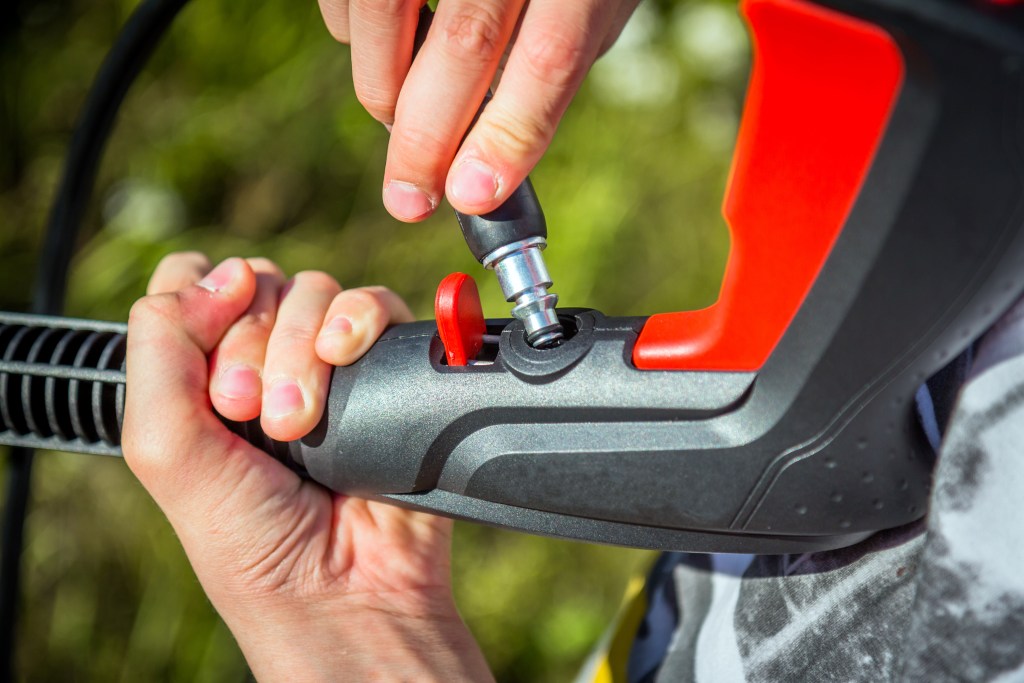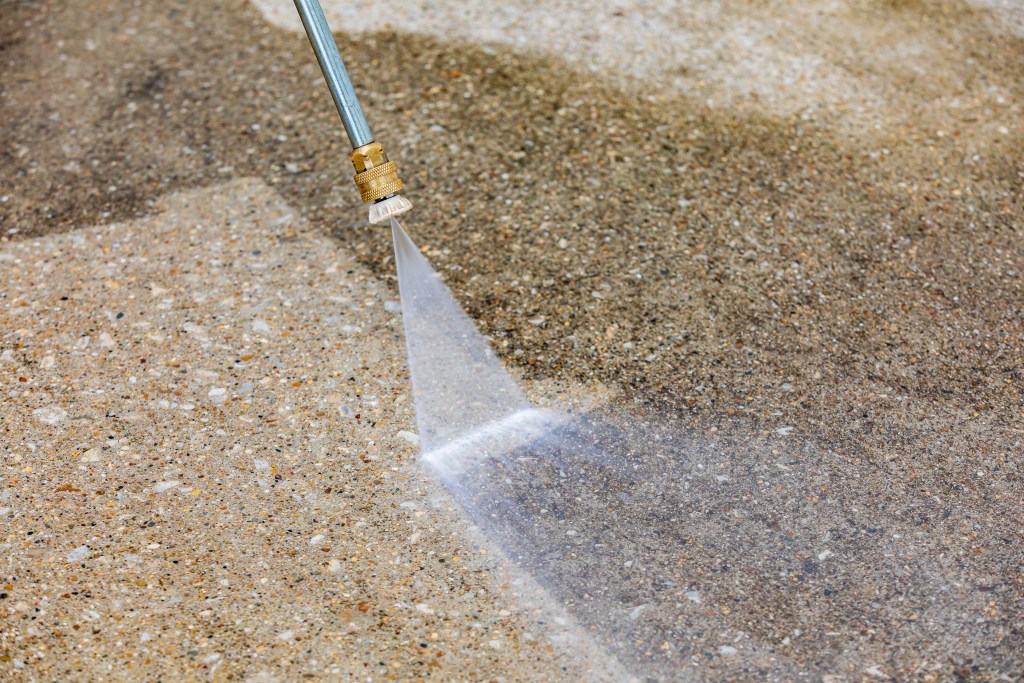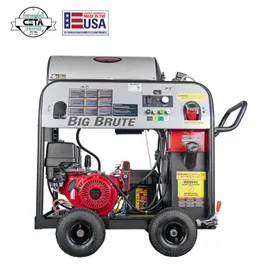Did you recently purchase a pressure washer? Or maybe you already had one, and it’s just been a while since you operated it? Don’t worry. This article will guide you through properly operating a pressure washer.
Commercial pressure washers can vary significantly in size, shape, and features. It may seem like a lot, but our experts have condensed everything you need to know into an easy-to-follow process.
Let’s take a look.
How to Use a Pressure Washer in 9 Steps
This step-by-step article will cover how to use an electric pressure washer, how to use a gas pressure washer, and how to use the soap dispenser on a pressure washer, all in just nine steps.
Keep in mind that gasoline-powered pressure washers and electric pressure washers are set up differently. Use the links below to toggle to the machine type you have.
- Prepare the Power Source
- Connect the Water Supply to the Water Inlet
- Connect the Pump Outlet to the Trigger Gun
- Connect the Wand to the Trigger Gun
- Select the Nozzle You Want to Use
- Attach the Nozzle
- Turn on the Water Supply
- Start the Commercial Pressure Washer
- Start Cleaning!
How to Use an Electric Pressure Washer
Let’s go over how to use an electric pressure washer.
1. Prepare the Power Source
For an electric pressure washer, you simply plug the cord into the correct outlet for its voltage.
Hot Water Boiler
If your commercial pressure washer has a hot water boiler, this is the time to fill the fuel tank. Make sure that you use diesel, not gasoline, to fill the boiler’s fuel tank.
2. Connect the Water Supply to the Water Inlet
You’ll need a garden variety hose for this step.
First, locate the water inlet on your pressure washer. The inlet will be located somewhere different on every commercial pressure washer, but it should be easy to find given that it’s the only place you can attach a garden hose to the machine.
You want to make sure that the connection is tight, as you’ll see moving forward it’s important to keep all connections tight, otherwise a number of issues can pop up. In this case, if the connection isn’t tight, you may experience low water pressure later on.
You can move on to the next step if the connection feels good.
3. Connect the Pump Outlet to the Trigger Gun
For this step, you want to use a high-pressure hose, not a garden variety hose.
The difference between a garden variety hose and a high-pressure hose is that, as the name implies, a high-pressure hose is made to withstand extremely high pressure and temperatures. You’ll notice that the threading is different, and the high-pressure hose is made of a thicker material, typically PVC, rubber, or polyurethane.

If you use a garden variety hose here, the water will tear through it.
Take the high-pressure hose and use it to connect the pump outlet to the trigger gun. This is another area where you want to make sure the connection is tight, otherwise you will experience high-pressure water coming out of the connections when you go to operate the commercial pressure washer.
Connect the Soap Injector
If you plan on using a soap injector, this step is when you connect it. Before reaching for the high-pressure hose, connect the soap injector directly to the pump outlet. Then, once it’s secure, connect the soap injector to the trigger gun with a high-pressure hose.
Before proceeding to the next step, ensure all connections are snug.



4. Connect the Wand to the Trigger Gun
Now that the commercial pressure washer unit is connected to the trigger gun, it’s time to connect the wand.
You want to align the trigger gun’s end with the wand’s base. Once aligned, you should be able to slide the base wand into the trigger gun. Push down and twist to lock the wand in place. Some brands may need to be screwed in place rather than a twist.
Tug at the wand to make sure it’s secured. If everything checks out, continue to step five.
5. Select the Nozzle You Want to Use
Depending on the commercial pressure washer you purchased, it may have come with only one nozzle. In that case, you can skip this step.


On the other hand, the commercial pressure washer may have come with an array of nozzles. Each nozzle has its own purpose. Some are for low-pressure applications, while others are for high-pressure applications; some generate a wide stream, and some generate a narrow stream. There are also specialty nozzles for use with the soap injector.
Choose the nozzle that corresponds with the cleaning task at hand and move on to the next step.
6. Attach the Nozzle
With all the main components connected and ready to go, you can now attach your nozzle of choice.
Connecting the nozzle is a two-step process. First, you want to pull back the collar at the end of the wand and hold it in place. Then, insert the nozzle into the end of the wand. Once it’s in place, release the collar. The nozzle should be locked in but give it a quick tug just to make sure.
After securing the nuzzle, your commercial pressure washer is almost ready. The last two steps are left before you can begin cleaning.
7. Turn on the Water Supply
Make sure that the water supply is on! It’s not uncommon for people to get this far and forget to turn the water supply on.
When they go to use the commercial pressure washer, no water comes out. Then, they’ll spend unnecessary time trying to troubleshoot common pressure washer issues when nothing is wrong with the machine.
After you turn on the water supply, it’s time to start the commercial pressure washer.
8. Start the Commercial Pressure Washer
To start your electric pressure washer, you must locate the start button or switch and press or flick it.


Hot Water Boiler
If your commercial pressure washer has a hot water boiler, you’ll find a separate start mechanism on the boiler’s body. The start mechanism is electric and can be activated with the press of a button or flick of a switch.
Give the boiler 5 minutes to warm up before you use the commercial pressure washer.
9. Start Cleaning!
You’re ready to start cleaning! Before you do, check out these tips for using a pressure washer for optimal results.
How to Use a Gasoline-Powered Pressure Washer
Let’s take a closer look at how to use a gasoline-powered pressure washer.
1. Prepare the Power Source
You must fill the fuel tank with the appropriate fuel for a gasoline-powered pressure washer. In most cases, this will be gasoline. However, it is always best to double-check the equipment’s manual before filling the tank.
Hot Water Boiler
If your commercial pressure washer has a hot water boiler, this is the time to fill the fuel tank. Make sure that you use diesel to fill the boiler’s fuel tank, not gasoline.
2. Connect the Water Supply to the Water Inlet
You’ll need a garden variety hose for this step.
First, locate the water inlet on your pressure washer. The inlet will be located somewhere different on every commercial pressure washer, but it should be easy to find, given that it’s the only place you can attach a garden hose to the machine.
You want to make sure that the connection is tight, as you’ll see moving forward it’s important to keep all connections tight, otherwise a number of issues can pop up. In this case, if the connection isn’t tight, you may experience low water pressure later on.
You can move on to the next step if the connection feels good.
3. Connect the Pump Outlet to the Trigger Gun
For this step, you want to use a high-pressure hose, not a garden variety hose.



The difference between a garden variety hose and a high-pressure hose is that, as the name implies, a high-pressure hose is made to withstand extremely high-pressure and temperatures. You’ll notice that the threading is different and the high-pressure hose is made of a thicker material, typically PVC, rubber, or polyurethane.
If you use a garden variety hose here, the water will tear right through it.
Take the high-pressure hose and use it to connect the pump outlet to the trigger gun. This is another area where you want to make sure the connection is tight, otherwise you will experience high-pressure water coming out of the connections when you go to operate the commercial pressure washer.
Connect the Soap Injector
If you plan on using a soap injector, this step is when you connect it. Before reaching for the high-pressure hose you want to connect the soap injector directly to the pump outlet. Then, once it’s secure, connect the soap injector to the trigger gun with a high-pressure hose.
Before proceeding to the next step, check to make sure all connections are snug.
4. Connect the Wand to the Trigger Gun
Now that the commercial pressure washer unit is connected to the trigger gun, it’s time to connect the wand.



You want to align the trigger gun’s end with the wand’s base. Once aligned, you should be able to slide the base wand into the trigger gun. Push down and twist to lock the wand in place. Some brands may need to be screwed in place rather than a twist.
Tug at the wand to make sure it’s secured. If everything checks out, continue to step five.
5. Select the Nozzle You Want to Use
Depending on the commercial pressure washer you purchased, it may have come with only one nozzle. In that case, you can skip this step.
On the other hand, the commercial pressure washer may have come with an array of nozzles. Each nozzle has its own purpose, some are for low-pressure applications while others are for high-pressure applications; some nozzles generate a wide stream and some generate a narrow stream. There are also specialty nozzles for use with the soap injector.
Choose the nozzle that corresponds with the cleaning task at hand and move on to the next step.
6. Attach the Nozzle
With all of the main components connected and ready to go, all that’s left is to attach your nozzle of choice.
Connecting the nozzle is a two-step process. First, you want to pull back the collar at the end of the wand and hold it in place. Then, insert the nozzle into the end of the wand. Once it’s in place, release the collar. The nozzle should be locked in but give it a quick tug just to make sure.
After securing the nuzzle, your commercial pressure washer is almost ready for use. All that’s left before you can begin cleaning are the last two steps.
7. Turn on the Water Supply
Make sure that the water supply is on! It’s not uncommon for people to get this far and forget to turn the water supply on.
They go to use the commercial pressure washer and no water comes out. Then, they’ll spend an unnecessary amount of time trying to troubleshoot common pressure washer issues when nothing is wrong with the machine.
After you turn on the water supply, it’s time to start the commercial pressure washer.
8. Start the Commercial Pressure Washer
Gasoline-powered pressure washers will either have an electric start or a manual start.


You’ll know whether the start mechanism is electric or manual based on whether it’s a button, switch, or pulley. For an electric start, just locate the button or switch and press or flick it. For manual start, locate the handle of the pulley and yank it.
Hot Water Boiler
If your commercial pressure washer has a hot water boiler, you’ll find a separate start mechanism on the boiler’s body. The start mechanism is electric and can be activated with the press of a button or flick of a switch.
Make sure to give the boiler 5 minutes to warm up before you begin using the commercial pressure washer.
9. Start Cleaning!
You’re ready to start cleaning! Before you do, check out these tips for using a pressure washer to get the most optimal results.
Tips for Using a Pressure Washer
Here are a few tips for using a pressure washer.
- Keep 6” – 10” Between the Surface and Nozzle
- Wash Vertical Surfaces From Top to Bottom
- Wash Flat Surfaces From the Back to the Front
- Advice for Cleaning
- Advice for Storage
Keep 6” – 10” Between the Surface and Nozzle
It’s ideal to keep a 6” – 10” distance between the surface and the nozzle of your commercial pressure washer.
The reason is twofold: first, you don’t want to get too close to the surface because the pressure washer can cause damage, and second, you don’t want to be too far from the surface; otherwise, you won’t get an adequate clean.
Wash Vertical Surfaces From Top to Bottom
This advice is true for most cleaning applications. The idea is that dirty water or slurry from the top washes downwards pushing it ahead of your cleaning path. If you wash bottom to top, the dirty water and debris will drop down onto areas you already cleaned.
The exception to this rule is that if you use a soap injector with your commercial pressure washer, apply it from the bottom up. Then, clean it from top to bottom.
Wash Flat Surfaces From the Back to the Front
Again, this advice is true for most cleaning applications. Like the last tip, you want to push the dirty water or slurry ahead of you as you clean. This is to avoid backing the dirty water or slurry into a corner where removing any already cleaned surfaces could be more difficult to remove without dirtying.
Advice for Cleaning the Commercial Pressure Washer
Cleaning a commercial pressure washer is straightforward. If common for dirty or grime to splash back onto the machine while it’s in use. All you need to do is wipe it down with a towel or rag. If you want to know more about preventive maintenance and other ways to extend the useful life of janitorial equipment, check out our blog!
Advice for Storing the Commercial Pressure Washer
All you need to know for storage is that you want to keep the commercial pressure washer in a dry, heated area. This prevents any water inside the pressure washer from freezing, which could damage internal components. Due to how the check valves are designed, some amount of water will always be sealed inside the pump and high-pressure hose.
Final Thoughts
If you’re looking for additional training on how to use a pressure washer, try reaching out to the experts at Imperial Dade. Get in touch with a member of our janitorial equipment team to set up a training session for you or your crew.
You can even arrange a live demo of any of our commercial pressure washers to see which is best suited to tackle your facility’s cleaning needs.